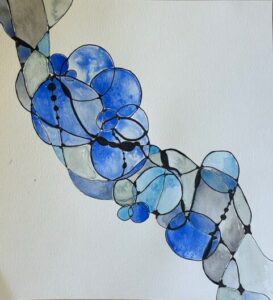What you learn today, for no reason at all, will help you discover all the wonderful secrets of tomorrow.
– Norton Juster, author (1929-2021)
Art-as-Therapy Workshops
A Healing Space for Recovery and Mental Wellness
Art-as-therapy workshops provide a safe, transformative space for individuals recovering from substance misuse or facing mental health challenges like anxiety, depression, suicidal ideation, dissociative disorders, or PTSD.
These workshops, facilitated by Tiny Art Stories Founder, Wendie Appel, certified trauma recovery coach and alcohol and drug recovery coach, integrate creative expression with evidence-informed approaches to emotional and psychological healing.
Why Art-as-Therapy?
Art can serve as a bridge to our deepest emotions, helping us process trauma, reframe difficult experiences, and navigate the path toward recovery. By engaging in art-as-therapy, participants can:
- Cultivate self-awareness, self-esteem, and autonomy
- Identify, regulate, and express emotions in a constructive way
- Develop new coping mechanisms and strategies for growth
- Foster self-reflection, reframe mindset
- Experience a sense of accomplishment and improved empowerment.
Participants often report feeling lighter, less anxious, and more centered after just one session. Through this creative process, they experience a transformative journey—becoming stronger, clear-minded, and connected to their values.
Workshop Structure and Topics
Workshops are 90 minutes to 2 hours long and focus on themes central to healing and personal growth, such as:
- Self-Forgiveness and Self-Acceptance
- Gratitude and Mindfulness
- Letting Go
- Overcoming Fear
- Identifying where Anxiety Lives in One’s Body
- Emotional Regulation
- Positive Mindset and Healthy Self-Talk
Each session begins with a brief discussion on the day’s topic, followed by the creation of a meaningful art project. Participants are encouraged to share their artwork (if they feel comfortable) and engage in a supportive wrap-up discussion. This process fosters growth, balance, and fulfillment.
The Healing Power of Creative Expression
Creating art is a powerful way to recall and reframe past traumas, navigate grief and loss, and confront feelings of shame or regret.
Completing an art project can bring a sense of accomplishment, empowerment, and satisfaction, while the creative journey deepens emotional processing and self-awareness. Creative Expression also fosters a sense of renewal, opening pathways for personal growth and transformation.
Facilitator Expertise
Workshops are thoughtfully designed and led by Wendie Appel, an artist with extensive knowledge of trauma healing, substance misuse recovery, and other disorders of the brain. Wendie’s training as a certified trauma recovery coach and alcohol and drug recovery coach, combined with her deep understanding of the creative process, allows her to provide a supportive and transformative experience for participants. Her compassionate approach ensures that individuals feel safe and empowered as they explore their creative potential in a warm, gratifying, and nonjudgmental environment.
Take the next step toward healing, growth, and self-discovery. Experience the transformative power of art as therapy.
A sampling of the workshops offered
Painting our Emotions
This workshop gives participants a starting point to identify emotions they may be feeling at that time. As a group we list the many different emotions and discuss how some are related. The results are revealing and allow the creator to ‘see’ what they are feeling.
Pictures from Painting our Emotions Workshops
Protection Shield
In this workshop, we assess our inner strengths and participants then create a Shield of Protection, labeling it with four of their inner strengths. The results are empowering, meaningful, satisfying, and build self-esteem.
Pictures from the Protection Shield Workshop
A Safe Place
Creating a safe place can assist with reducing stress associated with triggers, anxiety, and re-experienced trauma. A drawing can be used as a visual image to calm when the need arises. To begin, we spend some time thinking of our ideal safe place, wherever that may be.
Pictures from A Safe Place Workshop
Mandala Workshop
Mandala workshops are relaxing, fun, intuitive, and allow for a meditative quality of the mind and a calming effect on the body. Mandala work is often associated with wholeness, growth, or the emergence of something new.
Mandala work promotes serenity and reflection while reducing stress and anxiety.
Pictures from Mandala Workshops
Neurographic Art Workshop
A calming and meditative exercise, especially helpful for those with anxiety and depression, grief and loss, and many other stressors. Neurographic art allows the subconscious mind to work a particular problem that the participant identifies. The results are stunning, always unique, and revealing— a reflection of your inner-self.
Pictures from Neurographic Art Workshops















